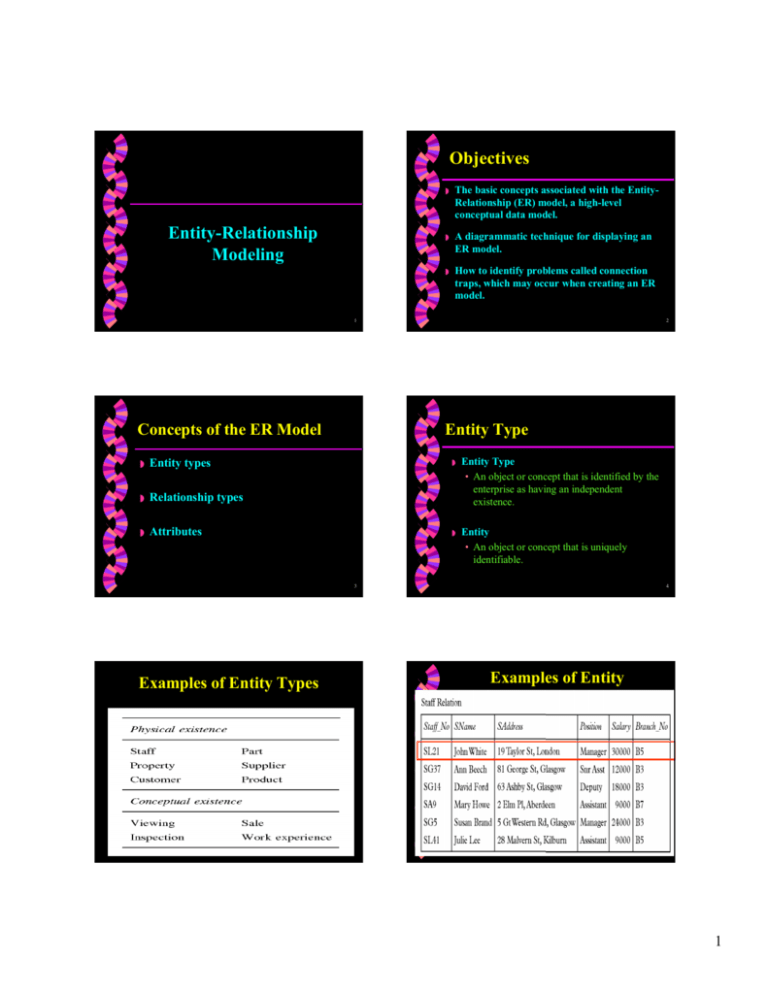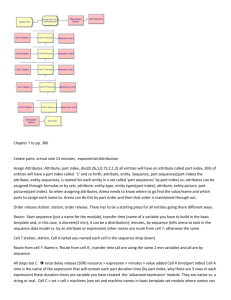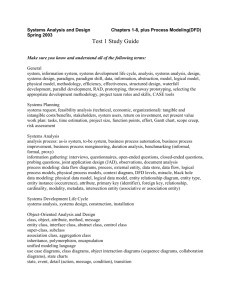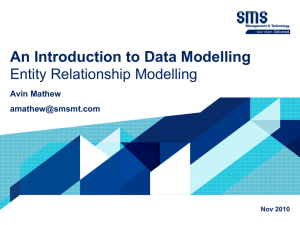Lecture 7
advertisement

Objectives Entity-Relationship Modeling ◗ The basic concepts associated with the EntityRelationship (ER) model, a high-level conceptual data model. ◗ A diagrammatic technique for displaying an ER model. ◗ How to identify problems called connection traps, which may occur when creating an ER model. 1 Concepts of the ER Model ◗ Entity types ◗ Relationship types ◗ Attributes 2 Entity Type ◗ Entity Type • An object or concept that is identified by the enterprise as having an independent existence. ◗ Entity • An object or concept that is uniquely identifiable. 3 4 Examples of Entity Examples of Entity Types 8 6 1 Diagrammatic Representation of Strong and Weak Entity Types Entity Type ◗ Strong Entity Type (parent, owner, dominant) Weak Entity Type • An entity type that is not existencedependent on some other entity type. ◗ Weak Entity Type (child, dependent, subordinate) Strong Entity Type • An entity type that is existence-dependent on some other entity type. 10 7 Diagrammatic Representation Relationship Type Relationship Types ◗ of Relationship Type • A meaningful association among entity types. ◗ Relationship • An association of entities where the association includes one entity from each participating entity type. 9 Diagrammatic Representation Weak Relationship Type 10 of Degree of a Relationship ◗ Staff Degree of a Relationship • The number of participating entities in a relationship. • The entities involved in a particular relationship are referred to as participants. Related to • The number of participants in a relationship is called the degree. Next_of_Kin 11 12 2 Binary Relationship called Owns Ternary Relationship called SetsUp 13 Quaternary Relationship called Arranges Recursive (Unary) Relationship ◗ Recursive Relationship • A relationship where the same entity participates more than once in a different roles. 24 16 Recursive Relationship called Supervises Recursive (Unary) Relationship ◗ Role name • To indicate the purpose that each participating entity play in a relationship 17 18 3 Entities associated through two distinct Relationships Attributes ◗ Attribute • A property of an entity or a relationship type. 19 20 Examples of Attribute Attributes ◗ Attribute Domain • A set of values that may be assigned to a single-valued attribute. 21 Examples of Attribute Domain 22 Types of Attributes Attribute Domain : 9000 -30000 23 ◗ Simple Attribute vs. Composite Attribute ◗ Single-Valued Attribute vs. MultiValued Attribute ◗ Derived Attribute 24 4 Attributes ◗ Attributes Simple Attribute Composite Attribute ◗ • An attribute composed of a single component with an independent existence. • An attribute composed of multiple components each with an independent existence. • Cannot be further subdivided as a meaningful information. • Can be further divides. • Ex. Sex, Salary • Ex. Address can be divided into Street#, City, State, Zip 25 Attributes ◗ 26 Attributes Single-valued Attribute ◗ Multi-valued Attribute • An attribute that holds a single-value for a single entity. • An attribute that holds multiple values for a single entity. • Customer#, Branch# • Tel_No : 234-5678 and 456-7839 27 28 Diagrammatic Representation of Attributes Attributes Multi-value attribute ◗ Derived Attribute SAddress SName • An attribute that represents a value that is derivable from the value of a related attribute or set of attributes, not necessarily in the same entity. DOB Position Staff Tel_No NIN Sex • Age attribute might be derived from DOB (Date of Birth) attribute Staff_No 29 Derived attribute Age Salary 30 5 Types of Key ◗ Keys Candidate Key ◗ ◗ Primary Key ◗ Composite Key Candidate Key • An attribute or set of attributes that uniquely identifies individual occurrences of an entity type. • Staff: Staff_No, >>>>> 31 Diagrammatic Representation of Attributes 32 Keys ◗ SAddress SName DOB Position • Staff: Staff_No, NIN (National Insurance Number), SName+Tel_No, SName+DOB NIN Sex Staff_No • An attribute or set of attributes that uniquely identifies individual occurrences of an entity type. Tel_No Staff Age Candidate Key Salary 33 Keys ◗ 34 Keys Primary Key ◗ • The candidate key selected to be a primary key Composite Key • A candidate key that consists of two or more attributes. • The consideration is based on: • attribute length (minimal) • current and future certainty of uniqueness • Staff: SName+Tel_No, SName+DOB • Staff_No 35 36 6 Diagrammatic Representation of Primary Key SAddress SName DOB ◗ A relationship can also has its own attribute. ◗ The presence of one or more attributes assigned to a relationship may indicate that the relationship conceals an unidentified entity. ◗ For example, the presence of the Date_View and Comments attributes on the Views relationship may indicate the presence of an entity called Viewing Position Tel_No Staff NIN Sex Staff_No Attribute on Relationships Age Salary Primary Key 37 38 Diagrammatic Representation of Entities, Relationships, and Primary Key Attributes Relationship called Views with attributes 39 40 7








